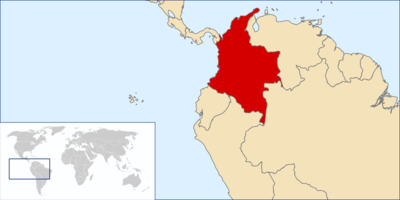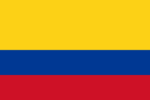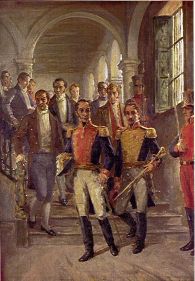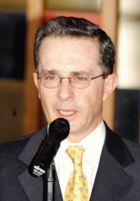Colombia
Colombia, formally the Republic of Colombia (Spanish: República de Colombia, re'puβ̞lika ð̞e ko'lombja), is a country located in the northwestern region of South America. Colombia is bordered to the east by Venezuela and Brazil; to the south by Ecuador and Peru; to the North by the Atlantic Ocean, through the Caribbean Sea; and to the west by Panama and the Pacific Ocean. Colombia is the only country in South America that borders both the Atlantic Ocean and the Pacific Ocean. Colombia is a large and physically diverse nation. It is the fourth-largest country in South America (after Brazil, Argentina, and Peru), with an area of 1,141,748 km² (440,839 sq. mi.), seven times greater than that of New England and more than twice that of France. Its vast territory is one of great physical contrasts, ranging from the towering, snowcapped peaks of the Andes to the hot, humid plains of the Amazon River Basin.
Colombia has a large population, estimated to be 42,090,502 in November 2006[1], larger than any other South American country except Brazil. The nation's population is not evenly distributed; most people live in the mountainous western third of the country, where the capital city of Bogotá, as well as most of Colombia's other large cities, are located. Most of the population speaks Spanish, the official language.
Colombia currently suffers from a low-intensity conflict involving rebel guerrilla groups, paramilitary militias, and drug trafficking. The conflict originated around 1964-1966, when the FARC and the ELN were founded and began their guerrilla insurgency campaigns against successive Colombian government administrations. However, since the election of Álvaro Uribe Vélez, the security situation has improved somewhat.
Flag
The current flag of Colombia is yellow, blue and red. The flag's original pattern was first created by Francisco de Miranda for Venezuela, later adopted for Gran Colombia after Simón Bolívar and others helped its constituent nations attain independence. The yellow represents the richness of the Colombian gold. The blue shows the two oceans that border North and West Colombia. The red represents the blood of soldiers of the people who fought and won the battle for independence.
Etymology
The word "Colombia" comes from the name of Christopher Columbus (Cristóbal Colón in Spanish, Cristoforo Colombo in Italian). It was conceived by the revolutionary Francisco de Miranda as a reference to the New World, especially to all American territories and colonies under Spanish and Portuguese rule. The name was then adopted by the Republic of Colombia of 1819 formed by the union of Venezuela, New Granada and Ecuador.
In 1830, when Venezuela and Ecuador separated, the Cundinamarca region that remained became a new country: the Republic of New Granada. In 1863 New Granada changed its name officially to United States of Colombia, and in 1886 adopted its present day name: Republic of Colombia.
History
See Colombia History
Circa 10000 BC, hunter-gatherer societies existed near present-day Bogotá (at "El Abra" and "Tequendama") which traded with one another and with cultures living in the Magdalena River Valley. Beginning in the first millennium BC, groups of Amerindians developed the political system of "cacicazgos" with a pyramidal structure of power headed by caciques. Within Colombia, the two cultures with the most complex cacicazgo systems were the Tayronas on the Atlantic Coast, and the Muiscas in the highlands around Bogotá, both of which were of the Chibcha language family. The Muisca people are considered to have had one of the most developed political systems in South America, after the Incas.
Spanish explorers made the first exploration of the Caribbean littoral in 1500 led by Rodrigo de Bastidas. Christopher Columbus navigated near the Caribbean in 1502. In 1508 Vasco Nuñez de Balboa started the conquest of the territory through the region of Urabá. In 1513, he was also the first European to discover the Pacific Ocean which he called Mar del Sur (or "Sea of the South") and which in fact would bring the Spaniards to Peru and Chile. In 1525, the first European city in the American Continent was founded, Santa María la Antigua del Darién in what is today the Chocó Department. The territory's main population was made up of hundreds of tribes of the Chibchan and "Karib", currently known as the Caribbean people, whom the Spaniards conquered through warfare, while resulting disease, exploitation, and the conquest itself caused a tremendous demographic reduction among the indigenous. In the sixteenth century, Europeans began to bring slaves from Africa.
Since the beginning of the periods of Conquest and Colonization, there were several rebel movements under Spanish rule, most of them either being crushed or remaining too weak to change the overall situation. The last one, which sought outright independence from Spain, sprang up around 1810, following the independence of St. Domingue in 1804 (today known as Haiti), who provided a non-negligible degree of support to the eventual leaders of this rebellion: Simón Bolívar and Francisco de Paula Santander. Simón Bolívar had become the first president of Colombia and Francisco de Paula Santander was the first vice-president, and when Simón Bolívar stepped down, Santander became the second president of Colombia. The rebellion finally succeeded in 1819, when the territory of the Viceroyalty of New Granada became the Republic of Great Colombia, as a Confederation which included present-day Ecuador, Venezuela, and Panama.
Internal political divisions led to the secession of Venezuela and Quito (today's Ecuador) in 1830. At this time, the "Department of Cundinamarca" adopted the name "Nueva Granada", which it kept until 1856 when it became the "Confederación Granadina" (Grenadine Confederation). In 1863 the "United States of Colombia" was created, lasting until 1886, when the country finally became known as the Republic of Colombia. Internal divisions remained, occasionally igniting very bloody civil wars and, eventually, contributing to setting the stage for the U.S.-sponsored secession of Panama in 1903. Soon after, the country achieved a relative degree of political stability, which was interrupted by a bloody conflict that took place between the late 1940s and the early 1950s, known as La Violencia ("The Violence"). Its cause was mainly due to mounting tensions between partisan groups, ignited by the murder of Jorge Eliécer Gaitán on April 9, 1948, an event later known as the Bogotazo. La Violencia claimed the lives of at least 180,000 Colombians.
Colombia's Constitution of 1886 was replaced by a new constitution ratified in 1991, which had been drafted by the Constituent Assembly of Colombia. The constitution included key provisions on political, ethnic, human and gender rights, which have been gradually put in practice, though uneven developments, surrounding controversies, and setbacks have persisted.
Colombia was also the first nation in the Americas and the second in the world to develop its own airline. The national airline of Colombia is Avianca.
Geography
Colombia is a very physically diverse country, containing tropical rain forests and permanently snow-capped mountains in relatively close proximity. The country is part of the Pacific "Ring of Fire", a region of the world characterized by frequent earthquakes and volcanic eruptions.
Colombia has four major geographic provinces: the Andes mountains with their deep intermontane valleys, the Pacific coastal lowlands, the Caribbean coastal lowands, and the llanos of the Amazon Basin.
Colombian surface features form complicated patterns. The western third of the country is the most complex. In the extreme west are the very narrow and discontinuous Pacific coastal lowlands, which are backed by the Serranía de Baudó, the lowest and narrowest of Colombia's mountain ranges. East of the Serranía de Baudó is the broad region of the Río Atrato/Río San Juan lowland. The chief western mountain range, the Cordillera Occidental, is a moderately high range with peaks reaching up to about 13,000 ft (4,000 m). The Cauca River Valley, an important agricultural region with several large cities on its borders, separates the Cordillera Occidental from the massive Cordillera Central. Several snow-clad volcanoes in the Cordillera Central have summits that rise above 18,000 ft (5,500 m). The valley of the slow-flowing and muddy Magdalena River, a major transportation artery, separates the Cordillera Central from the main eastern range, the Cordillera Oriental. The peaks of the Cordillera Oriental are moderately high. This range differs from Colombia's other mountain ranges in that it contains several large basins. In the east, the sparsely populated, flat to gently rolling eastern lowlands called llanos cover almost 60 percent of the country's total land area. In the north of the country are the Caribbean coastal lowlands and the Sierra Nevada de Santa Marta. The lowlands in the west are mostly swampy; the reed-filled marshes of the area are called ciénagas by the people of Colombia. The Guajira Peninsula in the northeast is semiarid. The Sierra Nevada is a spectacular triangular snowcapped block of rock that towers over the eastern part of this lowland.
Colombia's proximity to the equator strongly influences its climate. The lowland areas are continuously hot, with year-round temperatures over 30 °C (86 °F). Altitude affects temperature greatly. Temperatures decrease about 2 °C (3.5 °F) for every 1,000-foot (300-meter) increase in altitude above sea level.
Rainfall varies by location in Colombia, tending to increase as one travels southward. This is especially true in the eastern lowlands. For example, rainfall in parts of the Guajira Peninsula seldom exceeds 30 in. (75 cm) per year. Colombia's rainy southeast, however, is often drenched by more than 200 in (500 cm) of rain per year. Rainfall in most of the rest of the country runs between these two extremes.
Altitude also affects vegetation, and is the most important influences on vegetation patterns in Colombia. The mountainous parts of the country can be divided into several vegetation zones according to altitude, although the altitude limits of each zone may vary somewhat depending on the latitude.
The "tierra caliente" (hot land), below 3,300 ft (1,000 m), is the zone of tropical crops such as bananas. The tierra templada (temperate land), extending from an altitude of 3,300 to 6,600 ft (1,000 to 2,000 m), is the zone of coffee and maize. Wheat and potatoes dominate in the "tierra fría" (cold land), at altitudes from 6,600 to 10,500 ft (2,000 to 3,200 m). In the "zona forestada" (forested zone), which is located between 10,500 and 12,800 ft (3,200 and 3,900 m), many of the trees have been cut for firewood. Treeless pastures dominate the páramos, or alpine grasslands, at altitudes of 12,800 to 15,100 ft (3,900 to 4,600 m). Above 15,100 ft (4,600 m), where temperatures are below freezing, is the "tierra helada", a zone of permanent snow and ice.
Vegetation also responds to rainfall patterns. A scrub woodland of scattered trees and bushes dominates the semiarid northeast. To the south, savannah (tropical grassland) vegetation covers the Colombian portion of the llanos. The rainy areas in the southeast are blanketed by tropical rainforest. In the mountains, the spotty patterns of precipitation in alpine areas complicate vegetation patterns. The rainy side of a mountain may be lush and green, while the other side, in the rain shadow, may be parched.
Politics
Executive Branch
Colombia is a republic where the executive branch dominates government structure. Up until recently, the president was elected together with the vice-president by popular vote for a single four-year term; he functioned as both head of government and Head of State. However, on October 19, 2005, the Colombian Congress amended the constitution, which now allows Colombian presidents to serve up to two consecutive four-year terms. However, department governors, mayors of cities and towns and other executive branch officials are only elected for a three-year term, and cannot be immediately re-elected.
On May 28, 2006, president Álvaro Uribe Vélez was re-elected by a vote of 62%, with 22% going to Carlos Gaviria Díaz of the Democratic Pole, and 12% to Horacio Serpa Uribe of the Liberal Party.
Legislative branch
Colombia's bicameral parliament is the Congress of Colombia, or Congreso, which consists of the 166-seat House of Representatives of Colombia and the 102-seat Senate of Colombia. Members of both houses are elected by popular vote to serve four-year terms. Colombia also elects Department deputies and municipal councils.
Judicial branch
In the 1990s, the Colombian judicial system underwent significant reforms and is undergoing a process of migration from an inquisitorial system to an adversarial system. Parts of the coffee growing region of Colombia and Bogotá have already adopted the adversarial system, with the rest of the country following suit starting on January 1, 2006. The judicial system is headed by the Constitutional Court and members are appointed by Congress out of nominations made by the President and other high ranking tribunals.
Administrative divisions
Colombia is divided into thirty-two departments and one capital district (asterisked below).
Economy
The IMF Economic Indicators published on September 2006, forecast the Colombian GDP to reach US$149.869 billion in 2007. Inflation has been below 6% for 2004 and 2005, and is expected to remain below 5% during 2006.
Colombia's main exports include manufactured goods (41.32% of exports), petroleum (28.28%), coal (13.17%), and coffee (6.25%). Colombia is one of the largest producers of pop-up books in the world.[2] Colombia is also the largest exporter of plantains to the United States. Within Latin America, Colombia is known as a provider of fine lingerie, with the industry being centered in Medellín. All imports, exports, and the general trade balance are in record levels, and the inflow of export dollars has resulted in substantial revaluation of the Colombian Peso.
After experiencing decades of steady growth (average GDP growth exceeded 4% in the 1970-1998 period), Colombia experienced a recession in 1999 (the first full year of negative growth since 1929), and the recovery from that recession was long and painful. Colombia's economy suffers from weak domestic and foreign demand, austere government budgets, and serious internal armed conflicts.
The problems facing the country range from pension system problems to drug dealing to high unemployment. Several international financial institutions have praised the economic reforms introduced by current President Alvaro Uribe, which include measures designed to bring the public-sector deficit below 2.5% of gross domestic product (GDP). The government's economic policy and its democratic security strategy have engendered a growing sense of confidence in the economy, and GDP growth in 2003 was among the highest in Latin America.
Tourism
Colombia's famous festivals (such as the Cali Fair, the Barranquilla Carnival, the Iberoamerican Theater Festival and the Flower Festival) draw significant numbers of tourists to Colombia. Many people also come into Colombia during Christmas time and the celebrations surrounding the Independence of Colombia.[3]
Even though Colombia has been plagued with travel warnings because of FARC and other guerrillas groups, it has continued to attract more tourists in recent years. The apparent cause appears to be the current hardline approach of President Álvaro Uribe to push rebels groups farther away from the major cities and other tourist sites that may attract international visitors. Since President Uribe took office in 2002, he has notably increased Colombia's stability and security by significantly boosting its military strength and police presence throughout the country. This apparently has achieved fruitful results for the country's economy, particularly international tourism. In 2006, tourism officials are expecting approximately 1.5 million international visitors to visit Colombia, an astonishing increase of about 50% from the previous year. Even Lonely Planet, a world travel publisher, has picked Colombia as one of their top 10 world destinations for 2006.[4] The World Tourism Organization reported in 2004 that Colombia achieved the 3rd highest percentage increase of tourist arrivals in South America between 2000 and 2004 (9.2%). Only Peru and Suriname had higher increases during the same period.[5]
Ecotourism
- Colombian National Coffee Park (Montenegro, Quindío)
- Nevado del Ruiz National Park (near Manizales)
- Bogotá Botanical Garden (Bogotá)
- PANACA Park
- Tayrona Park (Santa Marta)
- Desierto de Tatacoa
- Chicamocha Canyon National Park
- Gorgona and Malpelo islands
- Museo del Oro (Museum of Gold), Bogotá
Crime
Colombia has become notorious for its illicit drug production, kidnappings, and murder rate. In the 1990s, it became the world's largest producer of cocaine and coca derivatives.[6] Cultivation of coca in 2000 was estimated at 163,300 hectares.[7]
For some time Colombia also had the highest murder rate in the world at 62 murders per 100,000 people.[6] However, the murder rate has declined in recent years to 39 murders per 100,000 people, bringing it below the levels of South Africa. Over 90 percent of people murdered are males. Regions like Putumayo, Guaviare and Arauca remain at 100 or more murders per 100,000 inhabitants in 2005. Neighbouring Venezuela, meanwhile, has seen a rise from 13 in 1991 to 33 murders per 100,000 inhabitants in 2005 and Ecuador has gone from 11 in 1991 to 18 in 2004.
Between 1992 and 1999 a total of 5,181 kidnappings, two-thirds of the world's reported, occurred in Colombia.[6] In the year 2005, 800 kidnappings were reported, (73% less than in 2002) of which 35% were rescued in the same year. In 2005, 18,960 vehicles were stolen(37% less than in 2002) and 18,111 persons were murdered(38% less than in 2002).[8]
Attribution
- Some content on this page may previously have appeared on Wikipedia.
Notes
- ↑ CONCEPTOS BÁSICOS SOBRE POBLACIÓN, DANE, 2007
- ↑ Montanaro, Ann. A Concise History of Pop-up and Movable Books. Retrieved on February 1, 2007.
- ↑ http://www.extremetourist.com/destinations/guide.php?country=Colombia&PHPSESSID=adf1f96f6e668d4711b8a8d8365c1934
- ↑ Hot Destination: Colombia, Christian Science Monitor, May 9, 2006.
- ↑ International Tourist Arrivals by Country of Destination, Tourism Market Trends, 2005 Edition, World Tourism Organization
- ↑ 6.0 6.1 6.2 Colombian Crime Statistics(1990´s)
- ↑ Coca cultivation in Andes stabilizes in 2005, farmers need help to find alternative livelihoods. United Nations Office on Drugs and Crime (June 20, 2006). Retrieved on December 29, 2006.
- ↑ Colombian Crime Statistics(2005)



